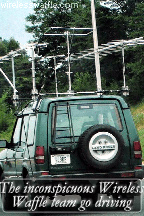Car journeys can be long and laborious, and, in many cases, just plain boring. However, for the avid radio DXer, they can also be an excellent opportunity to try and receive radio signals from far afield. This is especially the case for journeys that either run close to the sea (where tropospheric propagation may enhance distance reception), or over hills and mountains (where the elevated position of the receiver may increase line-of-sight). Further, many car radios are both sensitive and selective, making them great receivers to eke out weak signals.
 On a recent car journey across the UK, for example, Wireless Waffle was able to add Omroep Zeeland to the FM DX Logbook, despite radio reception conditions being what can only be described as 'as flat as the mountains of the Netherlands'. We thought, though, that it might be interesting to share our experiences of how a car journey can be turned into a DX-pedition (as they are known), safely and easily, as well as some very intriguing and unusual results.
On a recent car journey across the UK, for example, Wireless Waffle was able to add Omroep Zeeland to the FM DX Logbook, despite radio reception conditions being what can only be described as 'as flat as the mountains of the Netherlands'. We thought, though, that it might be interesting to share our experiences of how a car journey can be turned into a DX-pedition (as they are known), safely and easily, as well as some very intriguing and unusual results.
Playing around with your car radio whilst driving is probably a bad idea, and not that safe either, so the best thing to do is to tune to just a single frequency and see what crops up. How do you choose which frequency to tune to? In the example of Omroep Zeeland above, it was 87.9 MHz. This frequency is not used by any FM transmitters in the UK (check the list at frequencyfinder.org.uk) and as such, any transmissions you do hear are either going to be pirate radio stations, or iTrip type devices (more of which later). Many of the frequencies at the bottom end of the FM band including 87.8 and 87.6 are also good candidates but there may be others, depending on which area you live in (105.0 and 105.1 are also relatively ununsed in much of the UK).
 On these 'empty' frequencies what you will hear most of the time is 'ssssssshhh' (a.k.a. white noise). If there are others travelling with you on the journey, this can be extremely annoying, so this is a sport best played alone. However, from time to time, this noise will be punctuated by snippets of speech or music (which for a non radio funster, can be even more annoying than the noise).
On these 'empty' frequencies what you will hear most of the time is 'ssssssshhh' (a.k.a. white noise). If there are others travelling with you on the journey, this can be extremely annoying, so this is a sport best played alone. However, from time to time, this noise will be punctuated by snippets of speech or music (which for a non radio funster, can be even more annoying than the noise).
If you get enough speech or music to be able to identify the station, or (on occasion) get a signal for long enough, and strong enough, for RDS to appear, bingo, you've just landed yourself a DX catch. Even catching the language of the station and the style of programming may, in some cases, be sufficient to lead to an identification, especially if there are only a few stations in that language on a given frequency.
This is how Omroep Zeeland was identified. The language heard was clearly dutch, and it was a speech based program with occasional oldies music. According to fmscan.org, the following FM stations are within tropospheric range on a 'flat' band (i.e. a few 100 km at most), operate on 87.9 MHz, and are in the dutch language: There are no dutch speaking stations in Belgium on 87.9 and no other countries that speak dutch! Omroep Zeeland is a speech and oldies style station, where as Radio 10 is a music based station and although it plays oldies, it has far less speech content. Thus, identification of the snippets heard is relatively straightforward.
There are no dutch speaking stations in Belgium on 87.9 and no other countries that speak dutch! Omroep Zeeland is a speech and oldies style station, where as Radio 10 is a music based station and although it plays oldies, it has far less speech content. Thus, identification of the snippets heard is relatively straightforward.
One thing that did crop up whilst driving around listening to 87.9 and 87.5, was the number of strong signals that popped up with a strange variety of content from stories being read, to asian music and hip-hop. Whilst it would be easy to dismiss these as pirate radio stations, the fact that they appeared and disappeared relatively quickly tends to suggest that they were, in fact, 'iTrip' type transmitters connected to people's mobile phones, to allow music to be played on their car radios. These two frequencies are obvious choices for such devices given that they are not used for (legal) broadcasting in the UK.
An additional fun game that you can therefore give a go, is trying to work out which car driver is listening to which material. Who is the hip-hop fan, and who is listening to the x-rated audio book? Give 87.5 a try for this as it's repleat with lots of these iTrip type devices. I know what you are up to EK59 ESX!
 On a recent car journey across the UK, for example, Wireless Waffle was able to add Omroep Zeeland to the FM DX Logbook, despite radio reception conditions being what can only be described as 'as flat as the mountains of the Netherlands'. We thought, though, that it might be interesting to share our experiences of how a car journey can be turned into a DX-pedition (as they are known), safely and easily, as well as some very intriguing and unusual results.
On a recent car journey across the UK, for example, Wireless Waffle was able to add Omroep Zeeland to the FM DX Logbook, despite radio reception conditions being what can only be described as 'as flat as the mountains of the Netherlands'. We thought, though, that it might be interesting to share our experiences of how a car journey can be turned into a DX-pedition (as they are known), safely and easily, as well as some very intriguing and unusual results.Playing around with your car radio whilst driving is probably a bad idea, and not that safe either, so the best thing to do is to tune to just a single frequency and see what crops up. How do you choose which frequency to tune to? In the example of Omroep Zeeland above, it was 87.9 MHz. This frequency is not used by any FM transmitters in the UK (check the list at frequencyfinder.org.uk) and as such, any transmissions you do hear are either going to be pirate radio stations, or iTrip type devices (more of which later). Many of the frequencies at the bottom end of the FM band including 87.8 and 87.6 are also good candidates but there may be others, depending on which area you live in (105.0 and 105.1 are also relatively ununsed in much of the UK).
 On these 'empty' frequencies what you will hear most of the time is 'ssssssshhh' (a.k.a. white noise). If there are others travelling with you on the journey, this can be extremely annoying, so this is a sport best played alone. However, from time to time, this noise will be punctuated by snippets of speech or music (which for a non radio funster, can be even more annoying than the noise).
On these 'empty' frequencies what you will hear most of the time is 'ssssssshhh' (a.k.a. white noise). If there are others travelling with you on the journey, this can be extremely annoying, so this is a sport best played alone. However, from time to time, this noise will be punctuated by snippets of speech or music (which for a non radio funster, can be even more annoying than the noise). If you get enough speech or music to be able to identify the station, or (on occasion) get a signal for long enough, and strong enough, for RDS to appear, bingo, you've just landed yourself a DX catch. Even catching the language of the station and the style of programming may, in some cases, be sufficient to lead to an identification, especially if there are only a few stations in that language on a given frequency.
This is how Omroep Zeeland was identified. The language heard was clearly dutch, and it was a speech based program with occasional oldies music. According to fmscan.org, the following FM stations are within tropospheric range on a 'flat' band (i.e. a few 100 km at most), operate on 87.9 MHz, and are in the dutch language:
- Omrope Zeeland, transmitter site: Goes, transmitter power: 15kW
- Radio 10, transmitter site: Vught, transmitter power: 7.9 kW
 There are no dutch speaking stations in Belgium on 87.9 and no other countries that speak dutch! Omroep Zeeland is a speech and oldies style station, where as Radio 10 is a music based station and although it plays oldies, it has far less speech content. Thus, identification of the snippets heard is relatively straightforward.
There are no dutch speaking stations in Belgium on 87.9 and no other countries that speak dutch! Omroep Zeeland is a speech and oldies style station, where as Radio 10 is a music based station and although it plays oldies, it has far less speech content. Thus, identification of the snippets heard is relatively straightforward.One thing that did crop up whilst driving around listening to 87.9 and 87.5, was the number of strong signals that popped up with a strange variety of content from stories being read, to asian music and hip-hop. Whilst it would be easy to dismiss these as pirate radio stations, the fact that they appeared and disappeared relatively quickly tends to suggest that they were, in fact, 'iTrip' type transmitters connected to people's mobile phones, to allow music to be played on their car radios. These two frequencies are obvious choices for such devices given that they are not used for (legal) broadcasting in the UK.
An additional fun game that you can therefore give a go, is trying to work out which car driver is listening to which material. Who is the hip-hop fan, and who is listening to the x-rated audio book? Give 87.5 a try for this as it's repleat with lots of these iTrip type devices. I know what you are up to EK59 ESX!
2 comments
( 1443 views )
| permalink
| 



 ( 3.2 / 81503 )
( 3.2 / 81503 )




 ( 3.2 / 81503 )
( 3.2 / 81503 )

